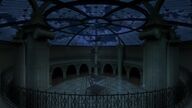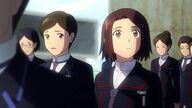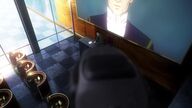Although the two are similar in story elements, certain scenes (such as the male and female protagonist hugging and welcoming the sunrise in mid-air), and some themes (such as the theme of love), there are still many differences between the two. The specific settings And the plot, the director’s style, the conception of the work, and the usual difference (only I can say "usually". After all, the former has works such as Little Round Face and Ghost in the Shell, and the latter also has works such as "Home Alone"; in the final analysis, both are a form of artistic expression. There is no limited content).
World view:
1. The world in "Inverted Patma" was formed from a failed experiment, or in fact, there is only one world, but the "victim" (let's say it) of the experiment lives in a refuge named "Aiga" So, I mistakenly thought that this is the whole world. The world of "World Against the World" is formed by the gravity of a double star, which are two opposite worlds of similar scale (in many senses), and people in one world can enter the other world, which appears to stand upright instead of upside down; then " "The World Against the World" also has "three laws" that seem to be awesome, such as the setting that the material contact between the two worlds will burn (in order to further highlight the difficulty of the male and female masters being together?).
2. The worlds of both sides have their own opposites. The former is more based on ideas. The rulers of the Aihe world regard the "upside down" inhabitants of the underground world as heretics, blasphemers, and sinners, trying to "purify" this "perfect". The latter is more manifested in the polarization of the rich and the poor, and Upside’s squeeze and exploitation of Downside. Three-dimensional works have a more realistic flavor.
stage:
The main stage of "Upside Down Patma" is the school (or citizen training (brainwashing), surveillance, and management organization), and the main stage of "The World Against the World" is the company. Well, after all, the potential audiences of the two are different. As the second stage, one is underground space and the other is Downside. Both are relatively simple, but the former has the feeling of a small village where the protagonist in the fairy tale came from, while the ruined walls and oil spill of the latter can only remind me of slums.
Characters:
1. The first perspective of "Inverted Patma" is the heroine, while the hero in "Upside Down" is the hero. Stories that extend from the perspective of the heroine are usually more tactful, subtle, and quieter (please don’t mention the "Charlie Girl" and "The Devil's Head"), while the story from the perspective of the heroine will be more direct and emotional Some; of course, this is also the style of the two directors, and may even be related to the difference in aesthetic appeal between the East and the West (for example, in the lifter, the two people face each other (front) for the first time. Stare, and at the same time say, "So you look at it from the front", then look at each other and smile, and then... the scene, I personally feel that there is a peaceful beauty).
2. The age difference between the two protagonists is about 10 years, which is probably the difference between the average age of the two audiences.
3. The heroes and heroines of "Inverted Patma" are to some extent looking for the figures of their parents (or similar people), one is adventurous, the other is looking up at the sky, and has been blessed by their parents (in man-made The dome provides a shelter, the key props of the KO villain's boss at the critical moment-the lifter of the fathers). It is often seen in animation works that in the difficult moments of the protagonist, the elders (teacher, relatives) will provide assistance in some form, even if it is only a little bit. The story of the parents is also an important clue in this work, following their footsteps and finally realizing their unfulfilled ideals. It can also be said that the story of Lagos and Youngji’s dad symbolizes the "friendship" between the two groups who have gradually become opposed after the accident (corresponding to the "love" between Patma and Youngji).
4. There is a sad but great male second in "The Upside Down Patma".
Theme:
1. "The Upside Down Patma" can be regarded as a certain religious metaphor, but it is more of a part of the setting. After all, the effective tool for spiritual unity/thought control is religion or similar propaganda.
2. Love. The biggest theme of "World Against the World" is love. The male and female protagonist breaks through all kinds of artificial or natural difficulties and obstacles, and finally emotionalizes the two worlds with their own love, which is a bit "love can overcome everything". But if it is filmed as a general "male cock chasing Bai Fumei", it will become a member of countless similar soap operas, so a variety of sci-fi settings are added; of course, "Upside down Patma" can also be described as a boy and a girl. The story of meeting and falling in love, embarking on a journey of discovery together, but love can only be regarded as one of the themes. In addition, the male and female protagonists in "The World Against the World" have known each other for many years and have grown up. Therefore, the advanced form of love is sex, and the ultimate form is to have children and move the world. It’s been acquaintance for a few days, one is still underage, so the advanced form of love is a kiss (my guess + expectation, after all, the atmosphere is so good and the lens is so wonderful, it’s a pity not to go up/off to kiss...), the ultimate form is Join hands on a journey of exploring a new world.
3. Unity and cooperation. Both involve topics. The former explores more in-depth, foreshadows and describes more (the cooperative shipbuilding of the fathers, the cooperative rescue of the boy and the boy two), and the latter shows the unity of the people of the world under the aura of love at the end. .
4. Reverse, reverse; frog at the bottom of the well. The "reversal" in "Inverted Patma" implies the taste of "abnormal", but this so-called "abnormal" is just a relative concept that exists in comparison, taking one's own standard as the standard for measuring everything. , Inevitably become a frog at the bottom of the well. The bottom of the refuge shattered and the world turned upside down again, which is undoubtedly the author's kind irony. In this film, there are descriptions of the personal feelings of the male and female protagonists in an upside-down state (fear, loneliness, and helplessness), which deepens the connotation of the word "upside-down".
5. Ideal feelings. Eiji is a boy looking up at the sky, and Patma is a girl who explores the unknown. The sky is an important image of this work, and it is also an important image of many literary works. There are unknown abysses, but there are also beautiful stars. Some people are afraid of the depth and the unknown, and dare not look up. They only allow others to stare at the ground. People have the courage to look up at the sky and embark on a journey to explore the unknown world.
Words of a family. above.
View more about Patema Inverted reviews











